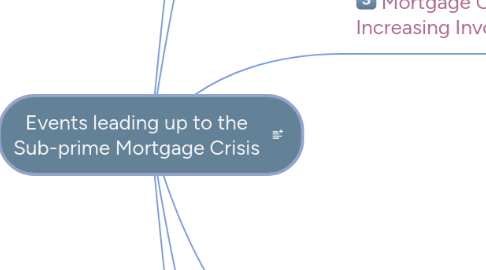
1. Rising Interest rates
1.1. FED raise interest rates 17 times between 2004-2006 to cool down an overheated economy ("Overheated Economy, n.d., para. 3)
1.2. 2004: Interest rates raised to 2.25%
1.3. 2005: Increased to 4.25%
1.4. 2006: Increased to 5.25%
1.5. Interest rates would rise throughout the economy
1.5.1. Cool down housing market
1.6. Homeowners more in debt as interest rates in loans increased
1.6.1. Homes are now becoming unaffordable
2. Real Estate Boom
2.1. Who? Homebuyers
2.2. Real Estate become attractive due to low interest rates
2.3. In 2002, increase in
2.3.1. Selling price of houses
2.3.2. No. of houses sold
2.3.3. Demand for mortgage loans increases
2.4. More people buying and selling property
2.5. Real Estate reached its peak at 2005-2006
3. Low Interest Rates
3.1. Who? Government; Federal Reserves
3.2. FED cut rates to 1.75% at the end of 2001 (lowest in 40 years)
3.3. 2002: Economy picked up
3.4. Rate cut to 1% in 2003
3.5. Why?
3.5.1. To stimulate the economy
3.5.2. Economy was at risk of deep recession after dot-com bubble and 2001 terrorist attacks
3.6. Affects?
3.6.1. Real Estate, Lenders & Investment Sectors
4. Mortgage Originators Increasing Involvement
4.1. Who? Mortgage brokers, Investment banks
4.2. Standard for loans become loose
4.2.1. Increase in demand for loans (esp. mortgage loans)
4.2.2. As interest rates low = less of a risk to give out more subprime loans (Low Mortgage rates)
4.2.3. Lend funds to people with poor credit and high risk of default
4.3. Secondary Mortgage Market
4.3.1. Increase use among lenders
4.3.2. Pack and sold mortgage & other loans to investment banks
4.3.2.1. e.g Residential Mortgage-Backed Securities (RMBS)
4.3.3. Investment banks securitize mortgage loans into bonds and sell them to investors
4.3.3.1. Collateralized Debt Obligation (CDO)
4.3.3.2. Rating agencies gave CDO's an AAA rating
4.3.3.3. Making CDO even more popular as they are given high creditworthiness
4.3.3.4. Repacked many times
4.3.3.4.1. Snowball effect
4.3.4. Once sold, get to collect originating fees
4.3.4.1. More funds to be loan out
5. BURST
5.1. How?
5.1.1. When did it burst?
5.1.1.1. Late 2007
5.1.2. Rising interest rates
5.1.2.1. FED interest rate as at 2007 Dec: 4.25%
5.1.3. Increase in foreclosure from 2006-2007
5.1.3.1. Homebuyers unable to pay off mortgage loans
5.1.3.1.1. Many had to default their mortgages
5.1.3.2. Houses become collateral
5.1.4. Investment banks declaring bankruptcy
5.1.4.1. Houses seize in foreclosure sold off at lower prices
5.1.4.1.1. Selling price lower than the cost of the subprime loan
5.1.4.1.2. A large number of houses seized (Adds to the supply )
5.1.4.2. Real estate market no longer booming
5.1.4.3. Loans are not paid
5.1.4.4. Investment banks are making large losses
6. Adjustable Mortgage Rates (ARM)
6.1. What?
6.1.1. Interest set below market level initially
6.1.1.1. Make payment seem affordable
6.1.2. Interest rates on ARM are reset periodically
6.1.2.1. Usually once a month
6.1.3. Re-adjusted to a high rate than the initial rate
6.2. Backfired
6.2.1. Raising rates of ARM caused borrowers to pay a high payment in the end
